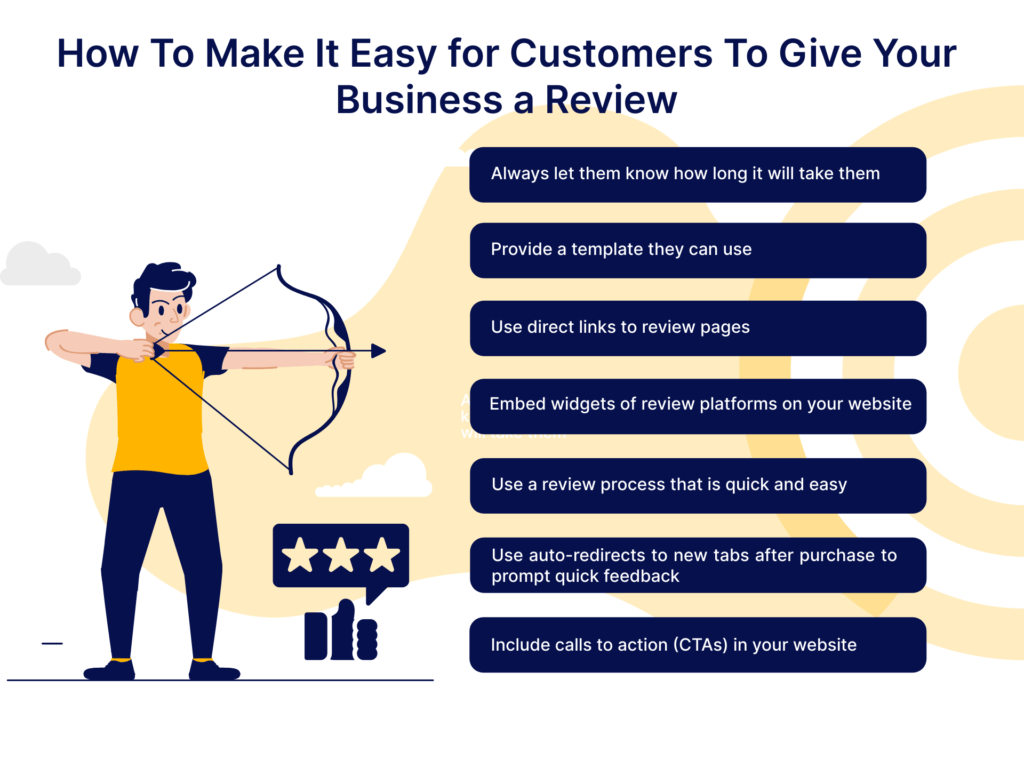Want to learn how to get reviews for your new business?
Starting a new business can be exciting. But let’s be real here for a moment; one of the toughest parts is convincing people to trust you. Without reviews, credibility, or a good reputation, new business owners feel like they’re shouting in a crowded place, hoping for customers to see them.

If you’re starting a business or looking for ways to build credibility in your industry, this is for you.
We’ll walk you through easy-to-apply, budget-friendly ways to collect reviews, boost your credibility, and turn those hesitant prospects into loyal customers.
10 Strategies To Get Reviews for a New Business
Here are 10 effective ways to get reviews for your new business
1. Start With Your Inner Circle
When starting a new business, your friends, family, and first customers are your biggest cheerleaders—especially if you offer good products and services. You can ask them for a review or feedback about your product or service.
For first-time customers, you can send a personal message or email. Here’s an example of what it can look like below:
“Hi [Customer’s name], I’d love to hear your thoughts about our (product/service). If you’re happy with it, would you mind leaving a quick review? It would mean so much to me!”
You can also offer something in return, like a small discount or exclusive access to a future product, to sweeten the deal (More on this later).
2. Offer Exceptional Customer Experience
Want reviews that can grow your customer base? The key is to deliver services or products that can turn anyone who buys from you into an advocate.
A survey by Salesforce shows that 72% of customers are willing to share their good experiences with others.
To build a list of happy and loyal customers, you’ll need:
- Consistency: Always deliver on your promises every time.
- Personalization marketing: Show customers you care by tailoring your products to their needs and experience.
- Responsiveness: Address questions and concerns quickly—it shows you’re professional and share in their concerns.
Happy customers are more likely to leave reviews, especially if you give them a little nudge (more on that next).
Also read: Nine Signs of Good Customer Service
3. Personalize Your Request
Timing and tone matter a lot when asking for reviews. It’s best practice to send follow-ups shortly after a customer interacts with your business while the experience is still fresh in their memory.
Automating the process makes it easier for online businesses. You can leverage email and SMS automation platforms to follow up with customers after a purchase or service. Tools like Mailchimp, Klaviyo, or HubSpot can send personalized review requests at the perfect time.
Here’s a tip: For an even better experience, include clickable star ratings in emails that redirect customers to the review platform.
4. Leverage Call to Actions
Using good copy and strong CTAs on your website can help guide your customers to give you a review. Businesses that offer physical products can also leverage CTAs by adding them to invoices or shipments. Another great idea is to include a call to action and a QR code that can redirect them to the review form.
5. Give Incentives, but Don’t Bribe!
You can offer little incentives in your campaign to encourage customers to spread the word about your business… but be ethical about it!
When getting reviews for your new business, it’s very critical to avoid paying for it (that’s a big no-no) or coming off as a business desperate for reviews. However, you can try any of these in your campaign:
- Loyalty points
- Discounts
- Coupons for future purchases
- Giveaway campaign
The idea here is to get your customers to buy more from you and experience what your brand is all about. And if you offer incredible customer experience, you’ll have advocates singing your praise in no time.
6. Make It Easy for Customers To Leave a Review.
Getting business reviews improves your chances of converting more customers. That’s why your business should be enlisted in relevant review platforms.
Whether you’re running a physical or online shop, being listed on different shopping sites can help customers easily give ratings where they are comfortable. And if there are review sites specific to your industry, you can always send an email to nudge them to rate you there.

Customers are more likely to give a review when the process is super easy. Making the process too long or too complicated may scare them away.
7. Leverage Online Platforms
There are several product review tools you can use to manage reviews in your business. You can do a little research to find one that works for your business, industry, and goals.
Examples of online review platforms include:
- Google Business Profile
- Yelp
- Trustpilot
- Amazon Customer Reviews
- Shopify Review Apps
- Yotpo
- Birdeye
- Trustmary
- Google Forms
8. Respond to Reviews
Listing your business on review platforms doesn’t come without a price. You have to respond to your customers’ reviews, good or bad (more on negative reviews later).
One of the crucial findings of BrightLocal’s recent annual survey about online reviews shows that 89% of customers would be ‘likely’ or ‘highly likely’ to use businesses that respond to all reviews.
A more intriguing finding is that 22% say they’re not likely at all to buy from businesses that don’t respond to any reviews.
This shows that when people leave reviews, they’re trying to engage with your brand. You can appreciate them for sending a review and addressing the negative reviews.
9. Pay Attention To Negative Reviews
Ever felt relieved after you got a proper response from a brand when you reached out online?
52% of customers in BrightLocal’s survey said they would buy from a business that responded to only negative reviews.
The reason for this is simple: your customers are humans, too.
Responding to their cares, needs, and experience with your brand shows how customer-centric your business is, putting empathy, compassion, and their needs first. Doing this and offering exceptional customer experience makes customers talk about your brand and pulls more people to it.
10. Leverage One-On-One Conversations With Your Customers.
This method is perfect for those who run businesses where they interact with their customers. It allows you to understand their needs, build rapport, and get more reviews and referrals.
For example, if someone tries out your services and thanks you for your customer service or talks about how nifty your product is, you can appreciate them and tell them you’d love them to be a part of your growth by sharing their thoughts on a review platform you use.
Of course, you can’t do this with every customer who comes your way because you don’t want to appear pushy. But you can take this opportunity on customers who genuinely share their joy of using your product or services.
That’s it: 10 ways new businesses can get reviews for their business.
Also read: Why Customer Satisfaction Is Important in Business
How To Handle Negative Reviews
Whether it’s a one-star critique or a frustrated comment, a negative review stings, especially after putting in a lot of work to improve customer experience, it’s understandable to feel defensive or defeated.
However, how you handle these reviews speaks more loudly about your business than tons of 5-star testimonials.
Why Your Company Should Embrace Negative Reviews
— Daniel Haslam 🏔 (@DanHaslam) December 9, 2024
Negative reviews can feel like a gut punch, but they’re actually one of the most valuable tools for growth and connection. In fact, nearly half of in-market shoppers go looking for them before they purchase.
Here's why:… pic.twitter.com/uFV3jeRKyw
Ever scrolled through reviews and been impressed by how a business owner responded to a negative review? How did you feel about them?
That’s how you can turn criticism into an opportunity.
Here are some ways business owners can handle negative reviews:
Don’t React! Pause and Ask Questions Instead
While it’s expected to get defensive or angry at a comment that’s far off from what your business is all about. Immediate reactions only lead to defensive and emotional replies that could do more harm than good.
Instead, take a deep breath. Ask yourself: What is this person really trying to communicate? Are they upset about the product, the service, or perhaps the way their issue was handled? Identifying the root cause will guide your response. Here’s a Tip: Draft your response in a separate document first. This gives you space to refine your tone before posting publicly. You can also ask for help with this.
Acknowledge Their Experience
Start by validating the customer’s feelings and show empathy with your words. This means putting yourself in your customer’s shoes and understanding their pain.
If you’re not sure what to say, you can start addressing the problem with sentences like, “We’re sorry to hear about your experience…” or “Thank you for bringing this to our attention…”
The idea is not about admitting fault right away; it’s about understanding their plight and making them feel heard, and then going ahead and finding out more about the problem.
Take the Conversation Offline
Although it’s important to show that you’re addressing the issue publicly, it’s best to handle some situations privately. Privately handling these issues allows you to ask more questions and get to the bottom of the problem.
You can do this by providing a direct email or phone number where they can reach you.
Here’s an example of a response that takes the conversation off the review platform:
“Hi [Customer’s name], we’re truly sorry to hear about this. Please email us at (support@business.com) or call [phone number] so we can make this right for you.”
Here’s a tip: Try as much as possible to fix the problem faster. Imagine getting a fix within the hour compared to days of back and forths. It’s all part of giving your customer a good experience. However, it is understandable that some complaints can take longer to deal with. In such cases, stay in touch with them and assure them you’re working on a fix.
Show Your Willingness To Improve
Even if the problem isn’t entirely your fault, let the customer know their feedback is valuable. Share what steps you’ll take to ensure it doesn’t happen again. You can also share tips on how they can avoid problems like that in the future.
Thank them for reaching out and make the necessary improvements. This demonstrates accountability and builds trust with not just the reviewer but anyone else reading the exchange.
Leverage the Positive Takeaways From the Experience
Negative reviews can feel overwhelming, but they’re one of the best ways to get insight and spot areas of improvement.
You can use them as a learning opportunity to refine your business. Ask yourself or your team: “What can we take away from this review to improve our customer experience?” Then, use the answers you get to upgrade and improve your products and services.
Bonus Tip: Don’t Delete a Negative Comment Without Proper Investigation
Sometimes, it’s tempting to remove negative reviews to keep your streaks of positive reviews. However, removing a review or complaint will only make the problem worse and affect your brand image.
It can make the customer more angry or make them see your brand as one that doesn’t care about its customers. Instead, handle negative reviews properly, and as they come, learn from them and give your customers a better experience with you. That’s how you get repeat customers.
After proper investigation, you may find that some customers are difficult to deal with. If offering help, fixing the problem, or reaching out doesn’t work, don’t sweat it; it happens. Instead, focus on improving, growing, and serving your customers well.
Final Thoughts: Deal With Reviews With the Golden Rule
The best way to get reviews for your new business is to put yourself in your customers’ shoes. What type of service or product will make you give high praise? How do you want your positive reviews to be received? How do you want your complaints to be addressed? How fast do you want a reply to a pressing problem?
Answering these questions and taking action that addresses the needs of your customers can help you get reviews for your new business. However, promptly replying to reviews and addressing complaints will help you build a stronger brand reputation.
Related Posts:













